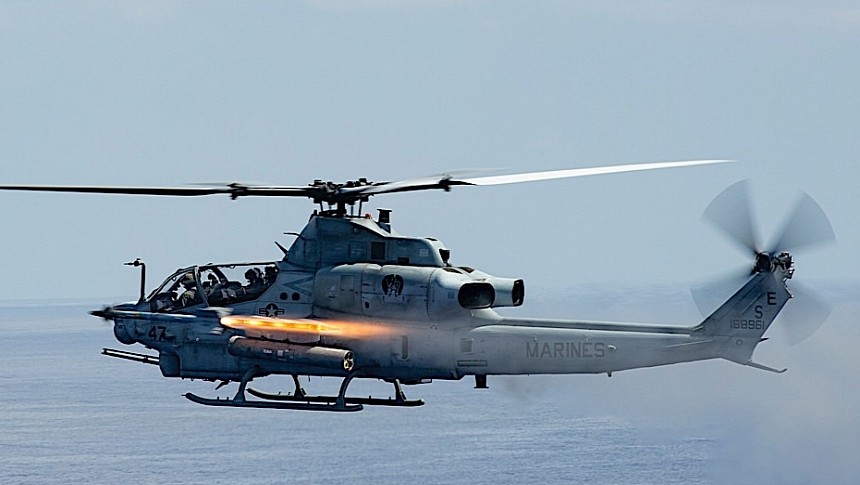In the world of aircraft there is no better way to gauge the success of a design than by counting the number of hours it stays in the air. This is done individually for safety reasons, and fleetwide for purposes of advertising the aircraft to the world.
Both civilian and military aircraft fleets take to the air regularly, so it's difficult to say which kind of machine is most used. Yet it is the military and military contractors that like to advertise operational milestones regularly, and that's what brought us here now.
A couple of decades ago, aerospace giant Bell introduced a pair of attack and utility helicopters unlike anything the world had ever seen: the AH-1Z Viper and UH-1Y Venom. For many, they were the most aggressively styled war machine ever made.
The two-seater Viper was specifically made to take on enemy forces from the air, using the power of rotary cannons, and a variety of rockets and missiles, something few other birds like it can do.
Powered by a couple of General Electric turboshaft engines, the Viper can fly at speeds of up to 230 mph (370 kph) for distances of up to 357 miles (575 km).
Its sibling, the UH-1Y Venom, is less attack and more utility. Sharing as much as 85 percent of components with the Viper, the Super Huey, as this one is known, is large enough to accommodate a crew of four and an extra eight soldiers in the back.
It too is quite capable, as it can reach speeds of 196 mph (315 kph) and distances of up to 374 miles (602 km).
At the time of writing, there are roughly 400 helicopters of both types flying in the service of the U.S. Marine Corps and a handful of allies (Bahrain, the Czech Republic, and Slovakia). And we were just announced that the half-a-million flight hours mark was reached across the fleet.
The announcement comes after back in 2021 the 400,000 flight hours mark was reached. It means that in just two years, 400 helicopters flew for a combined 100,000 hours. Since their introduction, it translates into each of the Bell Vipers and Venoms clocking on average 1,250 flight hours each. That's 52 full days of staying airborne!
And it's likely the numbers will increase even further. That's owed not only to the current state of the world, but also to the fact the two helicopters will continue to be used for decades.
Bell is currently in the process of upgrading the helos' capabilities through structural and electrical modifications, both meant to allow the integration of new and more modern capabilities.
As for cost, a single unit of the Bell machines is estimated to be worth roughly $75 million.
A couple of decades ago, aerospace giant Bell introduced a pair of attack and utility helicopters unlike anything the world had ever seen: the AH-1Z Viper and UH-1Y Venom. For many, they were the most aggressively styled war machine ever made.
The two-seater Viper was specifically made to take on enemy forces from the air, using the power of rotary cannons, and a variety of rockets and missiles, something few other birds like it can do.
Powered by a couple of General Electric turboshaft engines, the Viper can fly at speeds of up to 230 mph (370 kph) for distances of up to 357 miles (575 km).
Its sibling, the UH-1Y Venom, is less attack and more utility. Sharing as much as 85 percent of components with the Viper, the Super Huey, as this one is known, is large enough to accommodate a crew of four and an extra eight soldiers in the back.
It too is quite capable, as it can reach speeds of 196 mph (315 kph) and distances of up to 374 miles (602 km).
At the time of writing, there are roughly 400 helicopters of both types flying in the service of the U.S. Marine Corps and a handful of allies (Bahrain, the Czech Republic, and Slovakia). And we were just announced that the half-a-million flight hours mark was reached across the fleet.
The announcement comes after back in 2021 the 400,000 flight hours mark was reached. It means that in just two years, 400 helicopters flew for a combined 100,000 hours. Since their introduction, it translates into each of the Bell Vipers and Venoms clocking on average 1,250 flight hours each. That's 52 full days of staying airborne!
And it's likely the numbers will increase even further. That's owed not only to the current state of the world, but also to the fact the two helicopters will continue to be used for decades.
Bell is currently in the process of upgrading the helos' capabilities through structural and electrical modifications, both meant to allow the integration of new and more modern capabilities.
As for cost, a single unit of the Bell machines is estimated to be worth roughly $75 million.


































